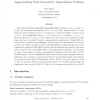Free Online Productivity Tools
i2Speak
i2Symbol
i2OCR
iTex2Img
iWeb2Print
iWeb2Shot
i2Type
iPdf2Split
iPdf2Merge
i2Bopomofo
i2Arabic
i2Style
i2Image
i2PDF
iLatex2Rtf
Sci2ools
APPROX
2009
Springer
2009
Springer
Approximating Node-Connectivity Augmentation Problems
The (undirected) Node Connectivity Augmentation (NCA) problem is: given a graph J = (V, EJ ) and connectivity requirements {r(u, v) : u, v ∈ V }, find a minimum size set I of new edges (any edge is allowed) so that J + I contains r(u, v) internally disjoint uv-paths, for all u, v ∈ V . In the Rooted NCA there is s ∈ V so that r(u, v) > 0 implies u = s or v = s. For large values of k = maxu,v∈V r(u, v), NCA is at least as hard to approximate as LabelCover and thus it is unlikely to admit a polylogarithmic approximation. Rooted NCA is at least as hard to approximate as Hitting-Set. The previously best approximation ratios for the problem were O(k ln n) for NCA and O(ln n) for Rooted NCA. In [Approximating connectivity augmentation problems, SODA 2005] the author posed the following open question: Does there exists a function ρ(k) so that NCA admits a ρ(k)-approximation algorithm? In this paper we answer this question, by giving an approximation algorithm with ratios O(k(1 ...
Algorithms | APPROX 2009 | Connectivity Augmentation | Node Connectivity Augmentation | Rooted NCA |
Related Content
| Added | 25 May 2010 |
| Updated | 25 May 2010 |
| Type | Conference |
| Year | 2009 |
| Where | APPROX |
| Authors | Zeev Nutov |
Comments (0)

